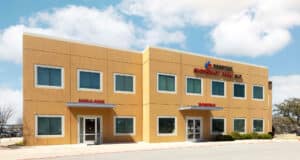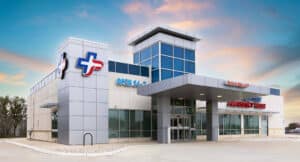Stroke Treatment and Emergency Care
Stroke is the fifth leading cause of death in the United States, impacting approximately 800,000 adults annually. Understanding the different types of strokes, recognizing their symptoms, and knowing what to do at the first sign can help minimize long-term or permanent complications.
What Is a Stroke?
A stroke, also known as a brain attack, occurs when blood flow to the brain is suddenly blocked, causing a rapid loss of neurological function. Symptoms vary widely from person to person, depending on the stroke’s location, size, location, and severity.
Types of Strokes and Their Symptoms
Strokes happen in two main ways. Approximately 85% of stroke cases are ischemic, which are caused by a blocked artery (blood clot) that disrupts blood flow to the brain. The remaining stroke cases are hemorrhagic, resulting from a leaking or ruptured blood vessel.
Ischemic Stroke
An ischemic stroke is a life-threatening condition caused by blocked blood flow to the brain. This blockage prevents brain tissue from getting the oxygen and nutrients it needs to function properly.
There are two main types of ischemic stroke: thrombotic and embolic. Thrombotic strokes result from a blood clot that develops in a blood vessel in the brain. Embolic strokes occur when a blood clot or plaque debris develops elsewhere in the body and travels to the brain.
An ischemic stroke and migraine are distinct medical conditions, but those with a history of migraine headaches—especially those with aura (visual disturbances)—have a slightly increased risk of stroke.
Hemorrhagic Stroke
A hemorrhagic stroke occurs when a weakened blood vessel ruptures and is a life-threatening medical emergency. Hemorrhagic stroke can happen in one of two ways:
- Bleeding inside your brain
- Bleeding into the space between your brain and its outer lining
Common causes of hemorrhagic stroke include:
- High blood pressure
- Blood vessel abnormalities
- Arterial dissection
- Clotting disorders
- Brain tumors
- Head trauma
- Diabetes
- Drug abuse
Transient Ischemic Attack (TIA)
A transient ischemic attack, often called a mini-stroke, occurs when blood flow to the brain is briefly disrupted, causing temporary stroke-like symptoms. This is often caused by tiny blood clots temporarily block a part of the brain.
Warning signs of a TIA include:
- Sudden weakness or numbness on one side of the face, arm, or leg.
- Sudden confusion, trouble speaking, or understanding.
- Sudden trouble seeing in one or both eyes.
- Sudden difficulty walking or balancing.
ER Treatment for Stroke
When you or a loved one arrives at Prestige ER with stroke symptoms, we immediately assess your symptoms and provide emergency interventions.
Initial Assessment in the ER
Within ten minutes of arrival to our emergency room, our medical team will assess your vitals and provide oxygen if necessary. Next, we will follow these steps to ensure prompt diagnosis and treatment:
- Rapid physical and neurological assessment using the FAST (Face, Arms, Speech, Time) protocol and NIH Stroke Scale (NIHSS) to properly assess the severity and nature of the symptoms.
- A brief but focused medical history, including when symptoms started, pre-existing medical conditions, and current medication list.
- Immediate diagnostic testing (e.g., CT Scan, MRI, EKG) to determine the kind of stroke you are experiencing and identify heart rhythm abnormalities.
- Blood tests to identify potential blood clotting issues, infection, or other abnormalities that may mimic stroke symptoms.
- Stroke-specific treatment.
- Hospital admission, ongoing care, and monitoring.
Emergency Interventions
If you or a loved one is experiencing stroke symptoms, call 9-1-1 or go to your nearest emergency room as quickly as possible for rapid response treatment. The sooner a stroke patient receives treatment, the better their chances of recovery.
Emergency interventions for stroke depend on the type of stroke and the time since symptoms began:
- Ischemic stroke
The primary treatment for ischemic stroke is a medicine called tissue plasminogen activator (tPA). It is given within 4.5 hours of the onset of symptoms and can help dissolve blood clots and restore blood flow to the brain to limit damage. - Hemorrhagic stroke
The main treatment for hemorrhagic stroke focuses on lowering blood pressure to reduce bleeding. Our team will also administer medicines to encourage blood clotting, prevent blood vessel spasms, and avoid seizures. - Brain surgery
If you have a large area of bleeding, surgery may be required to remove the blood and relieve pressure on your brain. Surgery may also be used to repair damaged blood vessels.
- Anticoagulants (blood thinners) to prevent blood clots from forming.
- Antiplatelet drugs to prevent platelets from clumping together to form blood clots.
- Statins to help lower cholesterol and other fats in the blood.
- Antihypertensives to help lower blood pressure.
- Call 9-1-1 immediately. The longer a stroke goes untreated, the higher the risk for long-term or permanent damage to the brain.
- Note the time you first see symptoms. Some medical interventions must be given within 4.5 hours of the start of symptoms to potentially reverse or stop symptoms from developing.
- Perform CPR, if necessary. Most stroke patients do not require CPR. However, if they are unconscious, check their pulse and breathing. If you find none, call 9-1-1 and start CPR while you wait for a first responder.
- Eat a well-balanced diet of whole grains, leafy green vegetables, fresh fruits, and lean meats. Choose foods high in fiber and low in saturated fat, trans fat, and sodium to help lower cholesterol.
- Maintain a healthy weight to improve blood flow and lower inflammation.
- Engage in regular physical activity to help lower blood pressure, a leading stroke risk factor.
- Avoid tobacco products and limit alcohol to encourage healthier blood pressure levels.
- Control medical conditions (e.g., diabetes, heart disease, high cholesterol, and high blood pressure) to lower your risk for stroke.
- Ischemic strokes: Blood pressure, thinners, and cholesterol-lowering medications.
- Hemorrhagic strokes: Blood pressure medications, diuretics or corticosteroids to reduce brain swelling, and anti-seizure medications.
- Transient ischemic strokes: Blood pressure medications, blood thinners, and cholesterol-lowering medications.
Medical Treatment for Strokes
If you or a loved one has experienced a stroke or are considered high-risk, the following medical treatments can help lower your risk:
FAQs About Stroke Treatment
How long does stroke recovery take?
Recovery time from a stroke varies depending on the person’s physical health and the severity of the stroke. Early recovery typically occurs within three to four hours after a stroke.
Longer-term recovery can take one to two years or more, and some may experience long-term or lifelong disabilities.
What should I do if I suspect someone is having a stroke?
Can strokes be prevented?
Yes, many strokes are preventable. It’s important to make healthy lifestyle choices and work with your healthcare team to control health conditions that increase your risk. Here are a few tips and strategies to help lower your risk for stroke:
What are the common medications used after a stroke?
The exact medications you need after a stroke depend on the type of stroke you had:
Choose Prestige ER for Emergency Medical Care
A stroke is a medical emergency—every moment counts. If you or someone you love is experiencing stroke symptoms, call 9-1-1 or go to Prestige Emergency Room immediately for rapid response treatment. Our expert team is ready to help with a broad range of medical emergencies, including potentially life-threatening ones.
We are a veteran-owned facility that provides personalized, expert care to you and your family 365 days a year, 24 hours a day. Find a location near you and visit us today.












